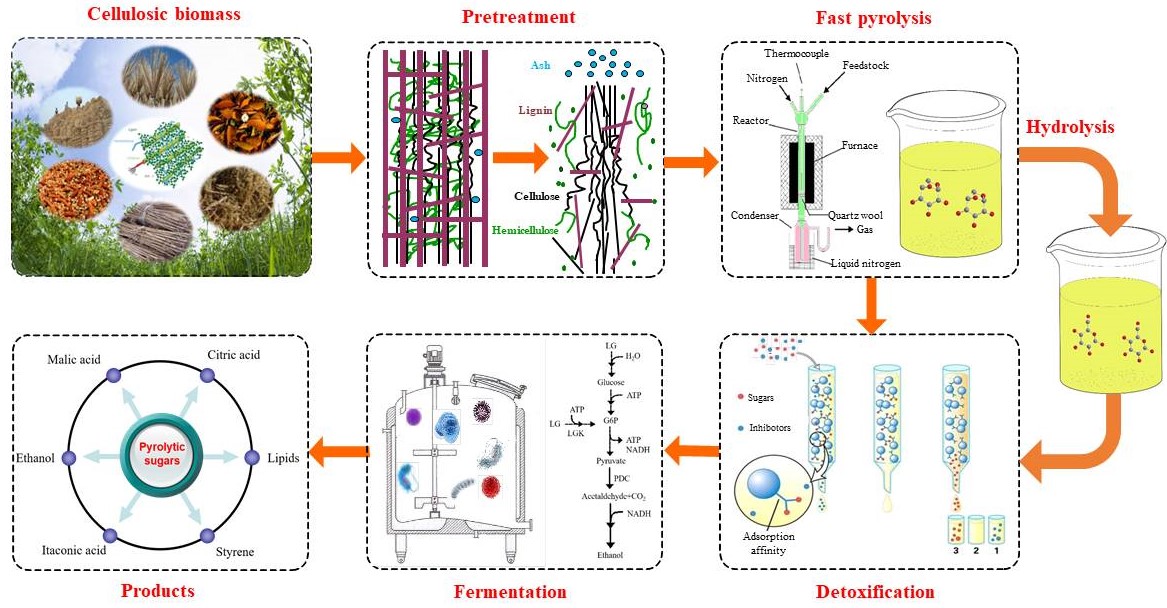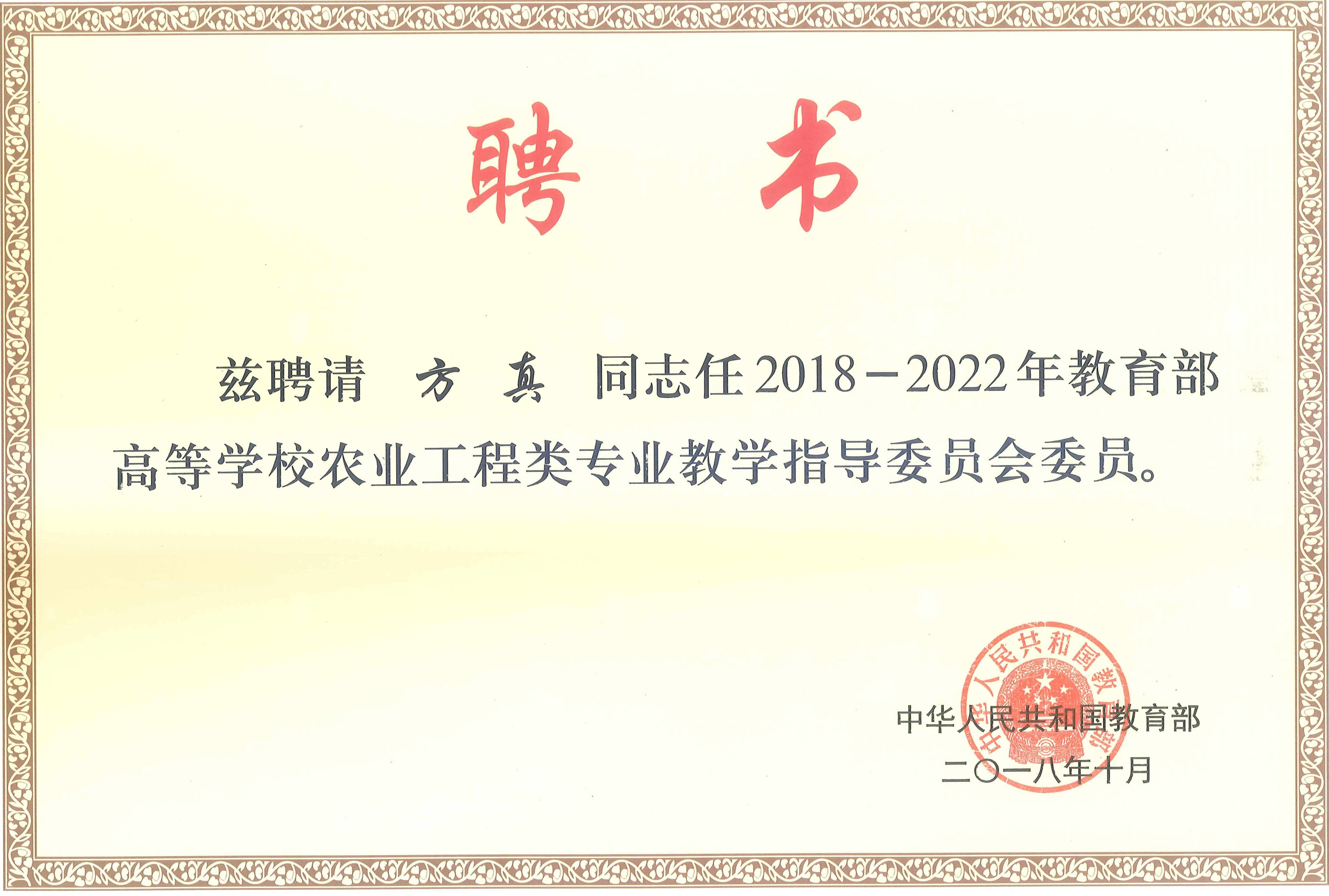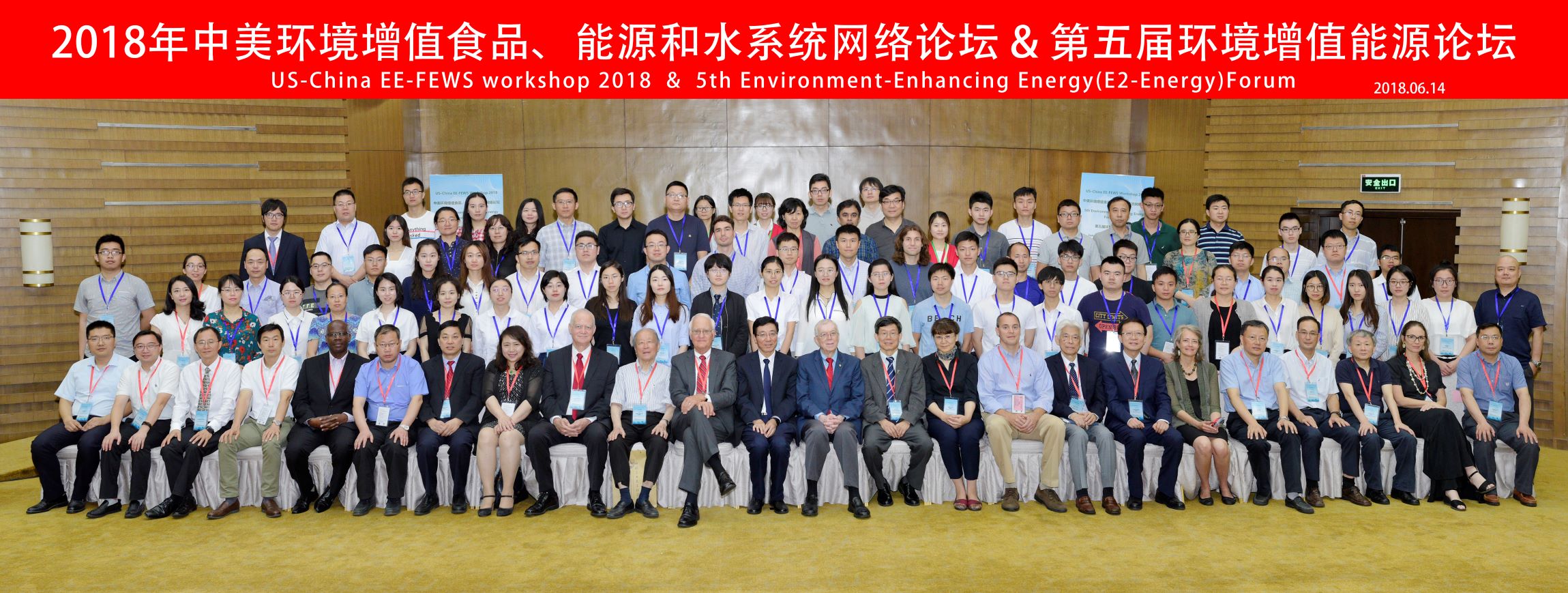A paper was published in Nature Communications
星期三, 30 1 月, 2019N-formyl-stabilizing quasi-catalytic species afford rapid and selective solvent-free amination of biomass-derived feedstocks
Recently, Dr. H Li and Prof. Zhen Fang, collaborated with Profs. M Watanabe & RL Smith Jr (Tohoku University, Japan) and Prof. EJM Hensen (Eindhoven University of Technology, The Netherlands), published a paper in Nature Communications about amination of biomass-derived feedstocks.
Nitrogen-containing compounds, especially primary amines, are vital building blocks in nature and industry. Herein, a protocol is developed that shows in situ formed N-formyl quasi-catalytic species afford highly selective synthesis of formamides or amines with controllable levels from a variety of aldehyde- and ketone-derived platform chemical substrates (that can be easily produced via our patented “fast hydrolysis” process from lignocelluloses and subsequent catalytic conversions) under solvent-free conditions. Up to 99% yields of mono-substituted formamides are obtained in 3 min. The C-N bond formation and N-formyl species are prevalent in the cascade reaction sequence. Kinetic and isotope labeling experiments explicitly demonstrate that the C-N bond is activated for subsequent hydrogenation, in which formic acid acts as acid catalyst, hydrogen donor and as N-formyl species source that stabilize amine intermediates elucidated with density functional theory. The protocol provides access to imides from aldehydes, ketones, carboxylic acids, and mixed-substrates, requires no special catalysts, solvents or techniques and provides new avenues for amination chemistry.
Related results were published:
H Li, HX Guo, YQ Su, Y Hiraga, Zhen Fang*, EJM Hensen, M Watanabe* & RL Smith Jr*, N-formyl-stabilizing quasi-catalytic species afford rapid and selective solvent-free amination of biomass-derived feedstocks, Nature Communications, 10, Article number: 699 (2019), https://doi.org/10.1038/s41467-019-08577-4.
Behind the paper:
———————————–
N-甲酰基稳定准催化物种促进生物质原料快速、选择性地无溶剂氨化生物质原料
最近,李虎博士和方真教授,与日本和荷兰科学家合作(日本东北大学RL Smith Jr教授和荷兰埃因霍温科技大学EJM Hensen教授研究组)合作,在《自然通讯》期刊上发表了一篇有关于氨基化生物质原料的文章。
含氮化合物, 特别是初级胺, 是自然界和工业原料的重要组成部分。本文中,开发了一种方案,其显示原位形成的N-甲酰基,准催化物质在无溶剂条件下从各种醛和酮衍生的平台化学底物(这可以很容易地通过我们的“快速水解”专利技术, 从木质纤维素水解和随后的催化转化获得)提供具有可控水平的甲酰胺或胺的高度选择性合成。该方案在3分钟内可获得高达99%的单取代甲酰胺产率。级联反应序列中普遍存在形成的C-N键和N-甲酰类化合物。动力学和同位素标记实验明确证明C-N键被活化用于随后的氢化,其中甲酸充当酸催化剂,氢供体和N-甲酰基物质源稳定胺中间体,已被密度泛函理论阐明。该方案提供了从醛、酮、羧酸和混合基质获得酰亚胺的途径,不需要特殊的催化剂、溶剂或技术,并为胺化化学提供了新的途径。
研究背景
(1)初步思考
2017年,我们(方真教授、RL Smith Jr教授、李虎博士)提交了中国南京农业大学和日本东北大学之间关于生物质生产高附加化学品的合作计划,李虎博士将在东北大学进行为期两年的博士后研究。在准备该计划时,我们撰写了一份关于生物质的综述(双功能固体催化材料:https://doi.org/10.1016/j.pecs.2016.04.004)并出版了一本关于双功能催化剂的书(双功能催化剂生产生物燃料和化学品,www.springer.com/gp/book/9789811051364)。在这些调查中,我们得出结论,生物质衍生原料的胺化将是一个很好的研究课题,但它需要我们开发高度复杂的催化反应系统,处理氢气或氨,并仔细优化给定原料的反应条件。例如,含有一个以上官能团的生物质衍生平台化学品(例如呋喃醛,如糠醛)的胺化不易用经典或非催化方法合成,因为呋喃环易于打开形成无规氨基物种。因此,需要一种新的方法,最终引导我们发现一些非常重要的化学反应。
(2)出乎意料的结果
我们的研究小组通过在流动条件下快速加热和混合原料来研究生物质的快速水解和材料生产(http://biomass-group.njau.edu.cn/info/1016/1256.htm)。我们想象如果我们能够将原料快速加热到反应条件,那么就有可能提高胺化的选择性。在小规模的微波加热对于原料(糠醛,甲酸铵,甲酰胺,甲酸)的快速加热是有益处的,幸运的是,我们小组有一个微波反应专家,他有一个合适的实验装置来测试这个想法。即使通过快速加热,我们也预估我们必须设计某种新型稳定的双功能催化剂来选择性地胺化糠醛。然而,当进行微波加热实验和分析时,揭示了非常意外的结果。值得注意的是,使用不同比例的甲酸和甲酰胺的快速加热速率的实验给出了选择性的胺化,其可以在没有多相催化剂的情况下在几分钟的反应时间内控制反应!
 图1 使用快速加热和甲酰胺与甲酸选择性胺化平台化学品以产生N-甲酰基物质。R1和R2可含有官能团。通过用甲醇处理相应的酰胺获得伯胺、仲胺或叔胺。
图1 使用快速加热和甲酰胺与甲酸选择性胺化平台化学品以产生N-甲酰基物质。R1和R2可含有官能团。通过用甲醇处理相应的酰胺获得伯胺、仲胺或叔胺。
这里,甲酸不仅作为H-供体,而且作为产生N-甲酰基物质的酸催化剂,其导致C-N键活化和稳定胺化中间体。
(3)机理
图2(顶部)显示了方案中糠醛的胺化和N-甲酰基稳定催化物质。从原位形成的N-甲酰亚胺或碳酰胺中间体可快速产生可检测量的偕二胺,FDFAM。为了在理论上研究该机制,我们增加了来自你荷兰埃因霍温科技大学的两名合作者,他们进行了DFT计算(图2,底部)。FDFAM中间体是高度稳定的,可以在微波和油浴加热实验中进行证实。
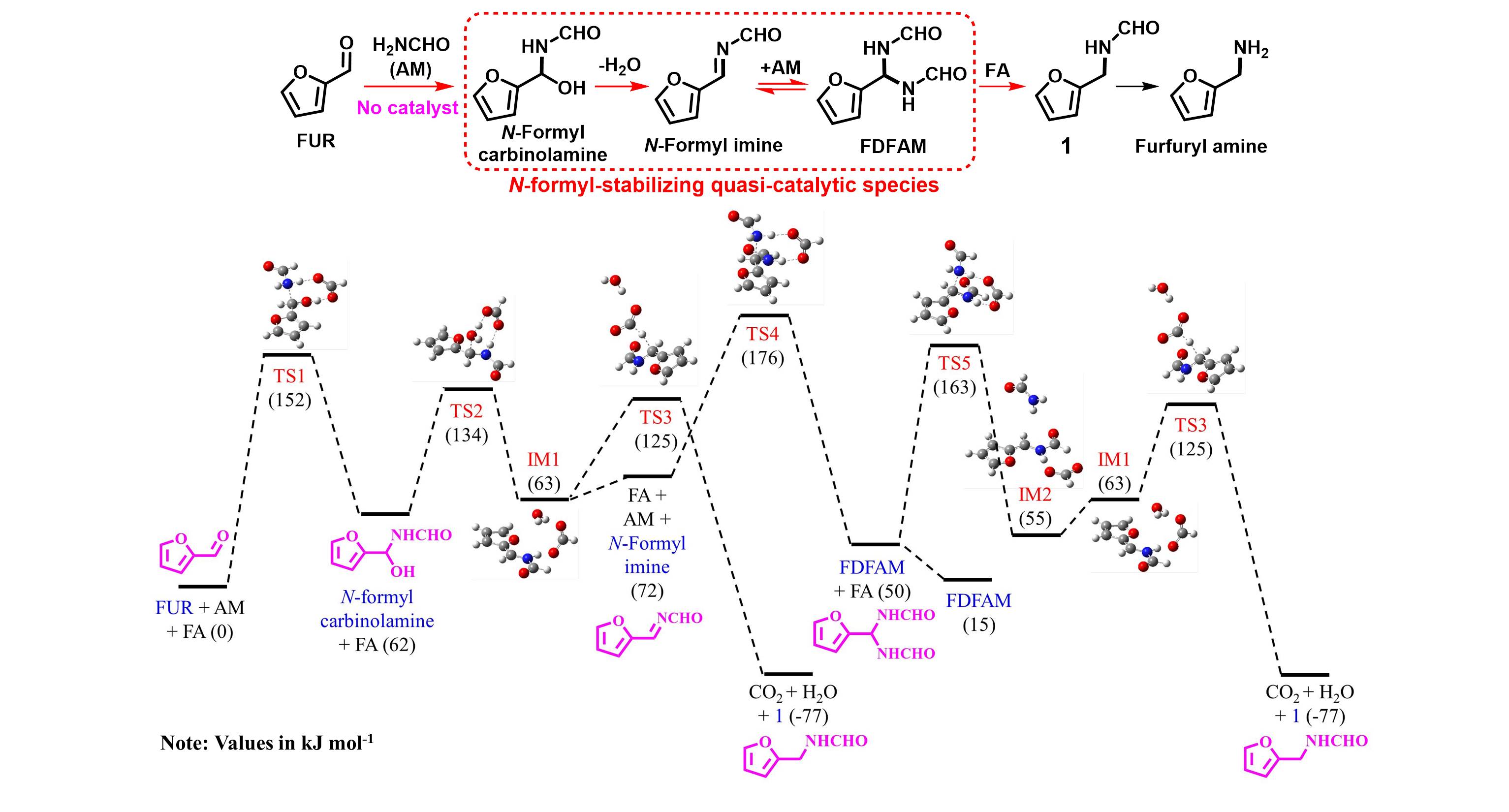 图2 使用甲酰胺(AM)与甲酸(FA)将糠醛(FUR)胺化为1,展示N-甲酰基稳定的准催化物质(顶部)和DFT计算,展示具有较低能量的中间体二胺(FDFAM)的途径(底部)。
图2 使用甲酰胺(AM)与甲酸(FA)将糠醛(FUR)胺化为1,展示N-甲酰基稳定的准催化物质(顶部)和DFT计算,展示具有较低能量的中间体二胺(FDFAM)的途径(底部)。
(4)广泛的使用范围
该方案广泛适用于生物质衍生的二氧化碳和N-甲酰亚胺的合成,用于由醛,酮,羧酸或它们的混合物生产组合化合物,无聚合物单体或杂环化合物,如反应所示(S1)-(S6)(图3)。
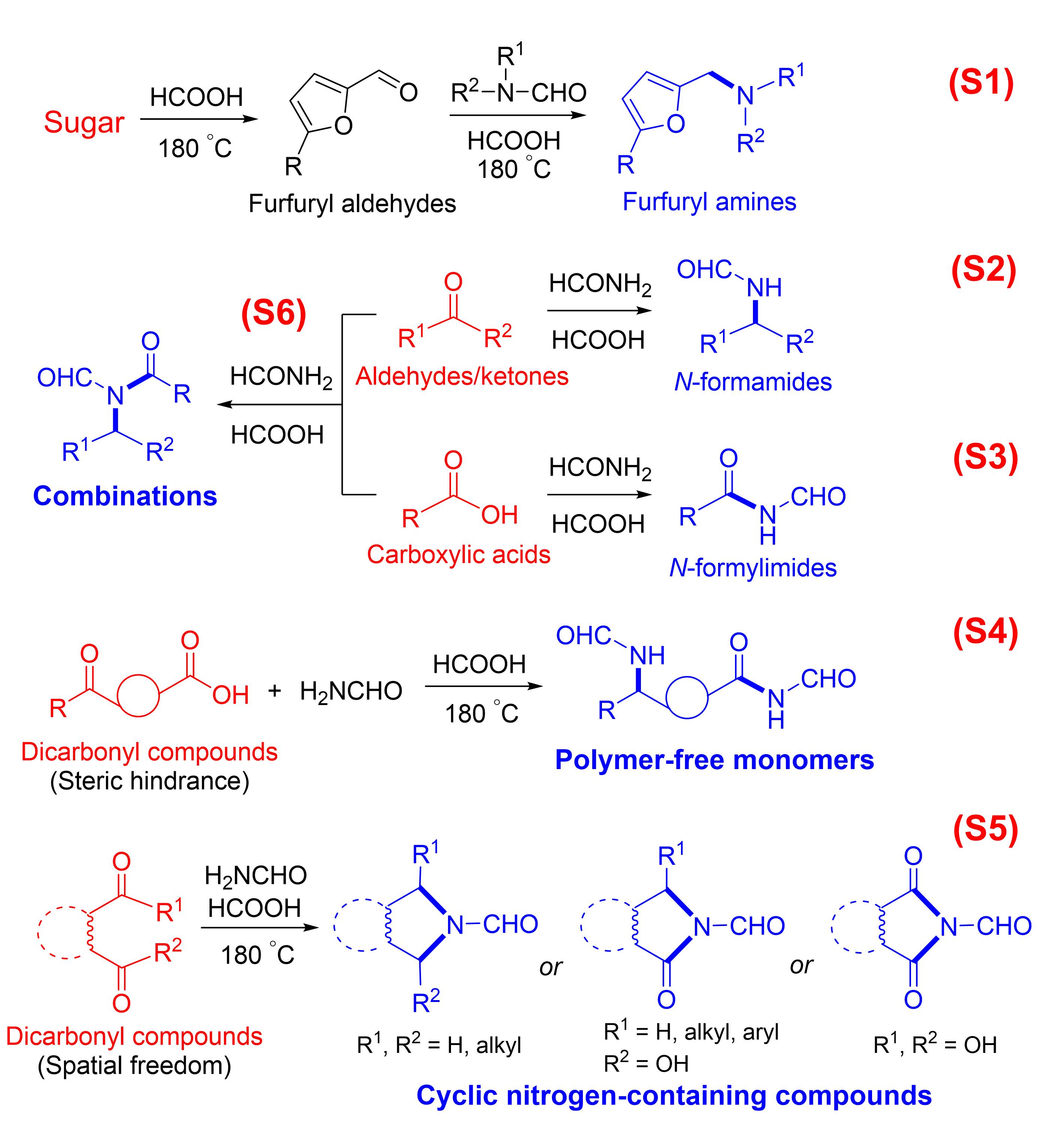 图3 将方案扩展到其他条件,显示使用范围的广泛性(S1-S6)
图3 将方案扩展到其他条件,显示使用范围的广泛性(S1-S6)
(5)新途径
该方案适用于流动化学研究,具有扩大规模的巨大潜力。此外,多相催化的使用可能用于增强本研究的各个方面或开发新的方案。
(6)总结
总而言之,无论是在研究方面,还是与才华横溢的国际成员合作,以及与自然的工作人员,编辑和审稿人合作,热情地帮助我们实现化学的潜力,这都是一段美妙的旅程。有关完整评论者的评论和作者回复,请参https://rdcu.be/bma7w 和支持材料。有关详细信息,请参阅我们的论文:
H Li, HX Guo, YQ Su, Y Hiraga, Zhen Fang*, EJM Hensen, M Watanabe* & RL Smith Jr*, N-formyl-stabilizing quasi-catalytic species afford rapid and selective solvent-free amination of biomass-derived feedstocks, Nature Communications, 10, Article number: 699 (2019), https://doi.org/10.1038/s41467-019-08577-4.
